Tyntesfield: Difference between revisions
Created page with "{{Infobox NT |name=Tyntesfield |county=Somerset |picture=Tyntesfield 1.jpg |picture caption=Tyntesfield, south side |type=Country House |style=Gothic Revival |client=William G..." |
m →Design: ioe -> nhle, replaced: {{IoE|33585 → {{NHLE|1129053 |
||
| Line 44: | Line 44: | ||
===Design=== | ===Design=== | ||
The house is built of two types of Bath Stone, and is highly picturesque, bristling with turrets and possessing an elaborate roof. The combined effect of the architecture and chosen materials has been described by Sir Simon Jenkins as "severe".<ref name=VicWeb/> During restoration, stonemasons either conserved or, on occasion, copy-carving new sections, carving new mouldings to replace standard architectural elements that formed the weathering, as well repointing most of the miles of lime pointing.<ref name=Minerva/> All stone was accurately matched to the original, with Veyzeys quarry near [[Tetbury]] providing Cotswold oolitic limestone.<ref name=Minerva>{{cite web |url=http://minervaconservation.com/projects/tyntesfield.htm |title=Tyntesfield |publisher=Minerva Conservation |accessdate=4 April 2013}}</ref> The house, which includes the servants' wing and the chapel, was made a Grade II* [[listed building]] in 1973,<ref>{{ | The house is built of two types of Bath Stone, and is highly picturesque, bristling with turrets and possessing an elaborate roof. The combined effect of the architecture and chosen materials has been described by Sir Simon Jenkins as "severe".<ref name=VicWeb/> During restoration, stonemasons either conserved or, on occasion, copy-carving new sections, carving new mouldings to replace standard architectural elements that formed the weathering, as well repointing most of the miles of lime pointing.<ref name=Minerva/> All stone was accurately matched to the original, with Veyzeys quarry near [[Tetbury]] providing Cotswold oolitic limestone.<ref name=Minerva>{{cite web |url=http://minervaconservation.com/projects/tyntesfield.htm |title=Tyntesfield |publisher=Minerva Conservation |accessdate=4 April 2013}}</ref> The house, which includes the servants' wing and the chapel, was made a Grade II* [[listed building]] in 1973,<ref>{{NHLE|1129053|Servants' wing and chapel}}</ref> and has since been upgraded to Grade I.<ref>{{NHLE|1129053|Tyntesfield House, servants wing and chapel}}</ref> | ||
The front (facing east over the gardens towards [[Backwell Hill]]) and north (entrance courtyard) are faced in one shade of ochreous Bath Stone,<ref name=Minerva/> while the south (rear), which is mainly allocated to the service area and servants quarters, is faced in cheaper red-tinged [[Draycott, Somerset|Draycott]] marble rubble,<ref name=Minerva/> and has some plastered finishes. All facades have many Gothic main windows, Tudor oriel windows, chimneys and attic dormers.<ref name=VicWeb>{{cite web |url=http://www.victorianweb.org/art/architecture/homes/1d.html |title=Tyntesfield|publisher=Victorian web |accessdate=4 April 2013}}</ref> Norton topped the design with an irregular roof, its various pitches and gables emphasising the building's asymmetrical architecture.<ref name=Minerva/> The final external addition was a huge ironwork conservatory by Hart, Son, Peard and Co. to the rear.<ref>{{cite web |url=http://www.countrylifeimages.co.uk/Image.aspx?id=77e9afb6-76c6-44ec-bec4-465a260aedbe&rd=2%7Cconservatory%7C%7C1%7C20%7C88%7C150 |title=Tyntesfield conservatory |publisher=Country Life Magazine |accessdate=4 April 2013}}</ref> The end result was described by novelist Charlotte Mary Yonge, a cousin of Blanche Gibbs, as "like a church in spirit".<ref name="OUPGibbs"/> | The front (facing east over the gardens towards [[Backwell Hill]]) and north (entrance courtyard) are faced in one shade of ochreous Bath Stone,<ref name=Minerva/> while the south (rear), which is mainly allocated to the service area and servants quarters, is faced in cheaper red-tinged [[Draycott, Somerset|Draycott]] marble rubble,<ref name=Minerva/> and has some plastered finishes. All facades have many Gothic main windows, Tudor oriel windows, chimneys and attic dormers.<ref name=VicWeb>{{cite web |url=http://www.victorianweb.org/art/architecture/homes/1d.html |title=Tyntesfield|publisher=Victorian web |accessdate=4 April 2013}}</ref> Norton topped the design with an irregular roof, its various pitches and gables emphasising the building's asymmetrical architecture.<ref name=Minerva/> The final external addition was a huge ironwork conservatory by Hart, Son, Peard and Co. to the rear.<ref>{{cite web |url=http://www.countrylifeimages.co.uk/Image.aspx?id=77e9afb6-76c6-44ec-bec4-465a260aedbe&rd=2%7Cconservatory%7C%7C1%7C20%7C88%7C150 |title=Tyntesfield conservatory |publisher=Country Life Magazine |accessdate=4 April 2013}}</ref> The end result was described by novelist Charlotte Mary Yonge, a cousin of Blanche Gibbs, as "like a church in spirit".<ref name="OUPGibbs"/> | ||
Latest revision as of 10:53, 19 September 2019
| Tyntesfield | |
|
Wraxall | |
|---|---|
|
National Trust | |
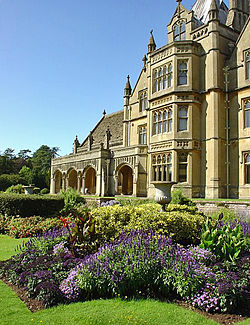 Tyntesfield, south side | |
| Location: | 51°26’25"N, 2°42’49"W |
| Built 1863 | |
| Information | |
| Website: | Tyntesfield |
Tyntesfield is a Victorian Gothic Revival house and estate near Wraxall in Somerset. The house is named after the Tynte baronets, who had owned estates in the area since about 1500.
A 16th-century hunting lodge once stood here, which was used as a farmhouse until the early 19th century. In the 1830s a Georgian mansion was built on the site, which was bought by the businessman William Gibbs, whose huge fortune came from guano used as fertilizer. In the 1860s Gibbs had the house significantly expanded and remodelled; a chapel was added in the 1870s.
The Gibbs family owned the house until the death of Richard Gibbs, 2nd Baron Wraxall in 2001.
Tyntesfield is today a Grade I listed building and owned by the National Trust, who bought it in June 2002, after a fundraising campaign.
History
Background
The land on which the house and its estate were developed was originally part of the Tynte family estate.[1] The family had lived in the area since the 1500s, but their primary residence was Halswell House in Goathurst, near Bridgwater.[2]
By the late 1700s, John Tynte owned what is now the Tyntesfield estate; at that time the house was approached by an avenue of elm trees, planted after they were bequeathed in the 1678 will of Sir Charles Harbord to the people of Wraxall in memory of two boys he had apprenticed from the village.[3] The Tynte's had originally lived on the estate,[4][5] but by the early 1800s, John had made Chelvey Court in Brockley his principal residence.[6] Tynte's Place was downgraded to a farmhouse and leased to John Vowles.[7] In 1813, George Penrose Seymour of the adjoining Belmont estate purchased the property and gave it to his son, the Rev. George Turner Seymour.[3] He in turn built a new Georgian mansion on the site of the former Saddler's Tenement, and demolished the old farmhouse.[3] Further remodelling was undertaken by Robert Newton of Nailsea.[8][9]
Purchase by the Gibbs family
In 1843 the property was bought by businessman William Gibbs, who made his fortune in the family business, Antony Gibbs & Sons. From 1847 the firm had an effective monopoly in the import and marketing to Europe and North America of guano from Peru as a fertilizer.[10] The firm's profits from this trade were such that William Gibbs became the richest commoner in Britain.[11]
Throughout his life, William Gibbs and his wife Matilda Blanche Crawley-Boevey (known as Blanche), principally lived in London,[12] for the greater part of his marriage at 16 Hyde Park Gardens, which the family owned until Blanche's death.[13] But as he travelled regularly on business to the Port of Bristol he required a residence in the area; thus it was, in 1843, he came to buy Tyntes Place, which he subsequently renamed Tyntesfield.[13] Within a few years of making his purchase, Gibbs began a major program of rebuilding and enlarging of the mansion.[14]
The architectural style selected for the rebuilding was a loose Gothic combining many forms and reinventions of the mediæval style. The choice of Gothic was influenced by William and Blanche Gibb's Anglo-Catholic beliefs as a followers of the Oxford Movement.[15] This wing of the Church of England particularly favoured the mediæval Gothic style, and "a return to the faith and the social structures of the Middle Ages".[16] The completion of the mansion's chapel further accentuated the building's mediæval monastical air so beloved by the Oxford Movement's devotees. When completed, the ecclesiastical design was reinforced by a dominating square tower with a steeply pitched roof adorned by four tourelles, which was demolished in 1935.[17]
Redevelopment

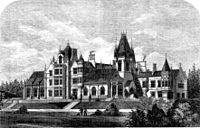
, 1886]]
In 1854 William Gibbs commissioned John Gregory Crace, an architect he was already using elsewhere, to redesign and decorate the principal rooms at Tyntesfield. These new designs included gilded panelling, woodwork, moulding and chimneypieces all in the Gothic style.[13]
Rebuilding work did not begin in earnest until 1863, when William Gibbs had the property substantially remodelled in a Gothic Revival style. William Cubitt & Co. were the builders and John Norton was the architect.[18] Norton's design enveloped the original house. He added an extra floor, two new wings and towers. Norton emphasised the importance of architectural continuity in restoration and rebuilding relating to several historical periods. As a result, while some walls remained plain, others were adorned with Gothic and naturalistic carvings to fit in with the previous architectural styles.[19]
Design
The house is built of two types of Bath Stone, and is highly picturesque, bristling with turrets and possessing an elaborate roof. The combined effect of the architecture and chosen materials has been described by Sir Simon Jenkins as "severe".[20] During restoration, stonemasons either conserved or, on occasion, copy-carving new sections, carving new mouldings to replace standard architectural elements that formed the weathering, as well repointing most of the miles of lime pointing.[19] All stone was accurately matched to the original, with Veyzeys quarry near Tetbury providing Cotswold oolitic limestone.[19] The house, which includes the servants' wing and the chapel, was made a Grade II* listed building in 1973,[21] and has since been upgraded to Grade I.[22]
The front (facing east over the gardens towards Backwell Hill) and north (entrance courtyard) are faced in one shade of ochreous Bath Stone,[19] while the south (rear), which is mainly allocated to the service area and servants quarters, is faced in cheaper red-tinged Draycott marble rubble,[19] and has some plastered finishes. All facades have many Gothic main windows, Tudor oriel windows, chimneys and attic dormers.[20] Norton topped the design with an irregular roof, its various pitches and gables emphasising the building's asymmetrical architecture.[19] The final external addition was a huge ironwork conservatory by Hart, Son, Peard and Co. to the rear.[23] The end result was described by novelist Charlotte Mary Yonge, a cousin of Blanche Gibbs, as "like a church in spirit".[13]
The interiors were also in the Gothic style. Crace was again engaged to remodel the interiors, in some places extending or adapting his initial works, in others providing new schemes. Other notable features of the house are glass by Powell and Wooldridge, ironwork by Hart, Son, Peard and Co. and mosaics by Salviati. George Plucknett was Cubitt's foreman, who was related to James Plunkett of Collier and Plucknett, furniture makers of Warwick. The result was that Gibbs ordered a number of specially commissioned pieces from the firm,[24] including a fully fitted bathroom for his wife. All of these fine pieces of craftsmanship were added to by Gibb's expanding collection of artworks.[13]
While the reconstruction on the house was being undertaken, William Gibbs had rented Mamhead Park in Devon.[25] The total cost of redevelopment to create a house with 23 main bedrooms and 47 in total including servants' accommodation came to £70,000: this sum was equivalent to 18 months’ gross profit from all of Gibbs's business interests.[26] After completion of the main building works, Gibbs created more cash by selling shares in Antony Gibbs & Sons to his nephew Henry Hucks Gibbs (later Lord Aldenham), which enabled him to purchase two adjoining properties – including Belmont to the east from his nephew George Lewis Monck Gibbs[27] – to create a farming estate, founded on dairy production and forestry management. Added to further by later land purchases, at its peak the Tyntesfield estate spanned over 6,000.0 acres (2,428.1 ha), encompassing 1,000 acres of forestry, from Portishead in the north to south of the valley in which the main house lay. The house and estate employed more than 500 workers.[13]
Chapel
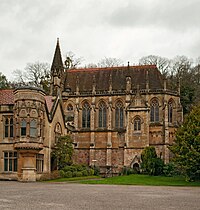
Gibbs' final addition to Tyntesfield was added between 1872 and 1877, when he commissioned Arthur Blomfield to add a Gothic chapel to the northside of the house. Modelled on Sainte-Chapelle in Paris,[15] it housed an organ by William Hills & Sons,[28] and below a vault in which Gibbs intended to be buried. However, combined opposition from both the vicar of the local All Saints Church, Wraxall and the church's patron, a member of the Gorges family, led to the Bishop of Bath and Wells decreeing that he would not sanction the consecration of Tyntesfield's chapel, through fears that it would take power away from the local population fully into Gibb's hands. Despite this, the chapel formed a central part of life at Tyntesfield, and prayers were said twice-daily by the family and their guests.[13] Throughout their period of residence, the family would also open the chapel to local people on an annual basis, often during Rogation days and at Christmas.[29]
In praise of the resultant final building, Yonge described the chapel as the final completion of the Tyntesfield project, providing "a character to the household almost resembling that of Little Gidding". Little Gidding in Huntingdonshire was the home of Nicholas Ferrar during the reign of Charles I, who was much idealized by 19th-century Anglo-Catholics.[13]
National Trust purchase
Concerned with the demolition and desecration of various historic country houses since the end of the Second World War, in the 1970s the National Trust commissioned architect Mark Girouard to catalogue and assess the remaining Victorian country houses across the United Kingdom for significance and structural integrity. He published his findings in a report, and later in the book The Victorian Country House, which in the revised second edition of 1976 included Tyntesfield as allowing access.[30] He said of the house:[31]
There is no other Victorian country house which so richly represents its age as Tyntesfield.
In the light of the report, the Trust placed Tyntesfield second on its covertous list of priorities for preservation.
In his later life, Richard Gibbs, with a large family, realised that inheritance tax would fall heavily on his estate, and Tyntesfield needed money spent on it which would be swept away in taxes, so he established a trust for sale for the benefit of 19 beneficiaries.[32] in which was placed the house and estate of 1,000 acres of farmland, 650 acres of woodlands, plus 30 houses and cottages, all valued at approximately £30 million.[33]
The National Trust were keen to acquire Tyntesfield. Rumoured competitors to buy it were reckoned by the media to have included composer Lord Andrew Lloyd Webber, and pop stars Madonna and Kylie Minogue.[34] The Trust launched a £35 million appeal in May 2002 via the "Save Tyntesfield" campaign, with celebrity support, which collected £8.2 million in just 100 days,[31] and £17.4 million in Lottery funds (with a further £25 million earmarked for the major conservation work).
The National Trust purchased only the main central part of the Estate which comprises the house, the kitchen garden, and the park, and sold off additional lands. The resultant preserved house and surrounding gardens sat on a total of 150 acres of land.
After taking ownership in 2002, National Trust staff secured the house and gardens, preserving them and the contents, and then catalogued the contents of the house which had been collected by the four generations of the family.
The house
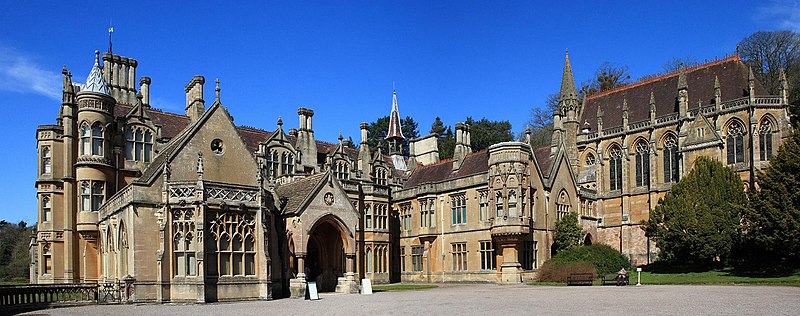
House interior
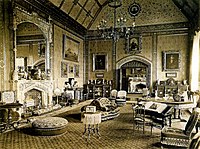
Principal rooms include the Library, Drawing Room, Billiard Room, Dining Room and Chapel.
The Library is regarded as the most important gentleman's library in the possession of the Trust. The carpet and some of the furnishings in the Library were designed by Crace,[35] whilst the book collection is the most extensive Victorian library collection owned by the Trust.[36]
The centre of the house is occupied by the hallway and staircase, which show the greatest number of changes since the original design.[37]
Once the Trust took ownership, scaffolding was placed in the hallway to repair the roof lantern. While this was in place the architectural paint analyst Lisa Oestreicher was able to examine the decorative scheme that had been used in the spaces and room frequented by the public. Three principal phases were identified: 1860s original; 1870s updates and adaptions; 1887–90 redecoration, which returned the main spaces to the original green colours and motifs created by Crace.[15] Once lantern repairs were complete, the Trust replaced the elderly chenille carpet destroyed by contractors working for Christie's with a new Wilton carpet.
Paintings
Many of the family's extensive collection of paintings, most sourced from Spain by William, were donated to the Trust. In part this was due to their poor condition, which involved not just water but also ironically guano damage. The most important painting in the collection is the 17th-century work by Zambrano of St Lawrence, which hangs in the middle of one of the walls of the hall. In 2011 the Trust bought the painting The Mater Dolorosa (Mother of Sorrows) by Bartolomé Esteban Murillo at Christie's auction in New York, which had hung at Tyntesfield since William purchased it until some time after 1910.[38]
Home Farm Visitor Centre
The Home Farm buildings were built in the 1880s, split over two levels. To the south is a two-storey covered yard with a timber roof structure, used for the rearing of farm animals. On the upper level is the main yard, where to the east and west are two wings, one side of which housed the former piggery. The farm offices make up the north wing, to fully enclose the square but gently south-sloping yard.[39]
The buildings needed full renovation, which took a secondary priority in the Trust's plans after the house. The Trust have converted the buildings into an integrated and self-contained visitor centre, which opened in mid-2011.[39] They house the ticket office, restaurant, play area and country crafts displays.
Park

The house sits within 150 acres of parkland. The wooded park leads down a tree-lined drive to balustraded terraces, and paths lead to the rose garden, summer houses, the aviary and the former concrete-lined lake, which has been empty since the Second World War.
Kitchen garden
The kitchen garden includes glasshouses and frames, the large classical Orangery and quarters for the gardeners.
Orangery

The Grade II* listed Orangery was once the architectural focal point of the kitchen garden complex.
Built in 1897, it is a rare surviving example of a late Victorian orangery in the Classical style, constructed from ashlar and red brick. It has a seven-bay east/west plan with central entrances and three bays north/south, topped by a fully glazed ironwork hipped-roof. An entablature with protruding horizontal geison sits above Ionic half-column supports and corner pilasters. The centre entrance bay on the west front towards the kitchen garden breaks forward as a portico, with pairs of giant engaged columns and broken pediment with a small oculus. Between each pair of columns are large round-headed windows with Gibbs surrounds and keystones.[40]
To preserve and restore the Orangery, the Trust teamed-up with City of Bath College and Nimbus Conservation Ltd in an innovative partnership, whereby 12 trainee stonemasons worked alongside professional craftsmen to hone their skills and carry out the specialist stonework needed. The Trust also introduced workshops for other restoration professionals, academics and eventually opened them to interested members of the public, where all were educated in a hands-on environment in the skills required to repair the building.
Today, while part of the Orangery is a dedicated café, the rest is an international education centre of excellence for the Trust, training new craftsmen and restoration specialists.[41]
Aviary
The aviary at Tyntesfield is situated to the west of the house, adjacent to the footings of the old conservatory. It was built in 1880 to house exotic birds, but was converted into a playhouse for Doreen, the first Lord Wraxall's daughter. The aviary is considered one of the most distinctive features of the estate,[42] and is Grade II listed.[43]
Sawmill
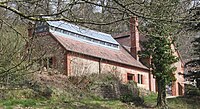
The sawmill stands where a foreman's office once stood, when the land was used for quarrying. The sawmill building was completed in 1899, providing electricity via two enclosed steam engines and pneumatic power across the estate. The engines were housed in what is now called the Engine Room, while the Lantern Room held multiple lead acid batteries. After opening, the decision was made to relocate the estate's entire sawmill to the building, to enable better access to electrical power. The steam engines were replaced by diesel generators, and electricity was provided from the national grid after the War. In the 1960s, the sawmill was decommissioned and all wood sold to third party contractors to be converted into sawn wood products.[44]
The Trust has renovated the sawmill and converted it into an educational centre and rentable function space. The building now houses the biomass boiler for the main house. Another section of the wood shed was used as a new roost site for bat species, creating a "bat palace".
Outside links
| ("Wikimedia Commons" has material about Tyntesfield) |
- Tyntesfield - information at the National Trust
- Tyntesfield photographic/panoramic tour from the BBC
- Stonemasons working at Tyntesfield
References
- ↑ Steven 2011, p. 1.
- ↑ Dunning 1992.
- ↑ 3.0 3.1 3.2 Wright 2003, p. 9.
- ↑ "Tyntesfield, Bristol, England". Parks and Gardens UK. Parks and Gardens Data Services Ltd. http://www.parksandgardens.org/places-and-people/site/3337/history. Retrieved 28 January 2014.
- ↑ National Heritage List 1000570: Tyntesfield
- ↑ Wright 2003, p. 7.
- ↑ Wright 2003, p. 17.
- ↑ "Reverend George Turner Seymour". Farringford. http://farringford.co.uk/tennyson/reverend_george_turner_seymour.htm. Retrieved 30 January 2014.
- ↑ Miller 2006, p. 39.
- ↑ Encyclopædia Britannica Ninth Edition. Adam & Charles Black. 1880.
- ↑ Miller 2006, p. 34.
- ↑ Hall 2009, p. 103.
- ↑ 13.0 13.1 13.2 13.3 13.4 13.5 13.6 13.7 "William Gibbs". Oxford University Press. http://www.oxforddnb.com/templates/article.jsp?articleid=89656&back=. Retrieved 2 April 2013.
- ↑ Miller 2006, pp. 59–64.
- ↑ 15.0 15.1 15.2 Schmitz, Sarah. "Tyntesfield Interiors". Building Conservation.com. http://www.buildingconservation.com/articles/tyntesfield-interiors/tyntesfield-interiors.htm. Retrieved 3 December 2013.
- ↑ Hill, Rosemary (24 February 2012). "Pugin, God's architect". guardian.com. http://www.guardian.co.uk/books/2012/feb/24/pugin-gothic-architect. Retrieved 19 March 2012.
- ↑ Pevsner 1973, pp. 348–349.
- ↑ Miller 2006, pp. 63–64.
- ↑ 19.0 19.1 19.2 19.3 19.4 19.5 "Tyntesfield". Minerva Conservation. http://minervaconservation.com/projects/tyntesfield.htm. Retrieved 4 April 2013.
- ↑ 20.0 20.1 "Tyntesfield". Victorian web. http://www.victorianweb.org/art/architecture/homes/1d.html. Retrieved 4 April 2013.
- ↑ National Heritage List 1129053: Servants' wing and chapel
- ↑ National Heritage List 1129053: Tyntesfield House, servants wing and chapel
- ↑ "Tyntesfield conservatory". Country Life Magazine. http://www.countrylifeimages.co.uk/Image.aspx?id=77e9afb6-76c6-44ec-bec4-465a260aedbe&rd=2%7Cconservatory%7C%7C1%7C20%7C88%7C150. Retrieved 4 April 2013.
- ↑ "Tyntesfield Hallway". Country Life Magazine. http://www.countrylifeimages.co.uk/Image.aspx?id=c69f5064-50b9-4a51-a7f9-079d2d5c33fa&rd=2%7Ctyntesfield%7C%7C1%7C20%7C34%7C150. Retrieved 4 April 2013.
- ↑ Hogg 2011.
- ↑ Miller 2006, p. 59.
- ↑ Wright 2003, p. 12.
- ↑ Miller 2006, p. 106.
- ↑ Wright 2003, p. 34.
- ↑ Girouard 1979.
- ↑ 31.0 31.1 "Trust 'hopeful' of buying historic mansion". BBC News. 14 June 2002. http://news.bbc.co.uk/1/hi/england/2045513.stm. Retrieved 2 April 2013.
- ↑ Miller 2006, p. 170.
- ↑ "'Remarkable' house for sale". BBC News. 13 March 2002. http://news.bbc.co.uk/1/hi/england/1871591.stm. Retrieved 2 April 2013.
- ↑ "Historic estate goes on sale". BBC News. 19 April 2002. http://news.bbc.co.uk/1/hi/england/1938469.stm. Retrieved 2 April 2013.
- ↑ Steven 2011, p. 4.
- ↑ "English Country House Libraries (page 4)". Beautiful Libraries. http://www.beautiful-libraries.com/3500-4.html. Retrieved 30 January 2014.
- ↑ Miller 2006, p. 137.
- ↑ "Old Master back in Tyntesfield's great hall ... after 100 years". Western Daily Press. 29 March 2011. http://www.westerndailypress.co.uk/Old-Master-Tyntesfield-s-great-hall-100-years/story-12325600-detail/story.html#axzz2PP5QABBq. Retrieved 2 April 2013.
- ↑ 39.0 39.1 "Farm buildings opened up for public to enjoy at Tyntesfield estate". Western Daily Press. 9 June 2011. http://www.westerndailypress.co.uk/Farm-buildings-opened-public-enjoy-Tyntesfield/story-12740095-detail/story.html#axzz2PP5QABBq. Retrieved 2 April 2013.
- ↑ Orangery at Tyntesfield - British Listed Buildings
- ↑ The orangery restoration - National Trust
- ↑ Twittering 1880s style at Tyntesfield estate - Bristol Evening Post
- ↑ National Heritage List 1061329: Aviary immediately north west of Tyntesfield House
- ↑ The story of the Sawmill Centre at Tyntesfield - National Trust
- Boyce, Michael (2012). Tyntesfield in WWII: The Story of an American Army Hospital 1943–45 and the Tyntesfield 'village' 1946–60. SilverWood Books. ISBN 978-1-78132-071-6.
- Goathurst: Manors - A History of the County of Somerset: Volume 6
- Girouard, Mark (1 July 1979). The Victorian Country House. Yale University Press. ISBN 978-0-300-02390-9.
- Greenacre, Francis W. (2003). Tyntesfield. National Trust. ISBN 978-1843590804.
- Hall, Michael (2009). The Victorian Country House: From the Archives of Country Life. Aurum Press. ISBN 978-1-84513-457-0.
- Hogg, David J. (2011). My Dear Uncle William, Tyntesfield Letters. ISBN 978-0-9554457-2-9.
- Lilwall-Smith, Andrew (2005). Period Living & Traditional Homes Escapes. Jarrold Publishing. ISBN 9780711735941. http://books.google.com/?id=5NS_jmUTVLMC&pg=PA119&lpg=PA119&dq=Tyntesfield+restoration+public#v=onepage&q=Tyntesfield%20restoration%20public&f=false.
- Miller, James (2006). Fertile Fortune – The Story of Tyntesfield. National Trust. ISBN 978-1-905400-40-9.
- Nikolaus Pevsner: Pevsner Architectural Guides
- Steven, Terry (17 January 2011). "History of the House and Family at Tyntesfield" (PDF). Kennet Valley National Trust. http://www.lovetts.eu/Tyntesfield.pdf. Retrieved 8 November 2013.
- Wakefield, Ken (1994). Operation Bolero: The Americans in Bristol and the West Country 1942–45. Crecy Books. ISBN 978-0-947554-51-4.
- Wright, Peter (1990). Villages at War. ISBN 978-0-9516257-0-5.
- Wright, Peter (June 2003). "Local Memories & Research – Pennant Special No.8: Tyntesfield" (PDF). Nailsea and District Local History Society. http://www.ndlhs.org.uk/ebooks/Tyntesfield-Local-Memories.pdf. Retrieved 3 April 2013.
Further reading
- Hogg, David J. (2009). Diaries of Tyntesfield. David J. Hogg. ISBN 978-0-9554457-3-6.
